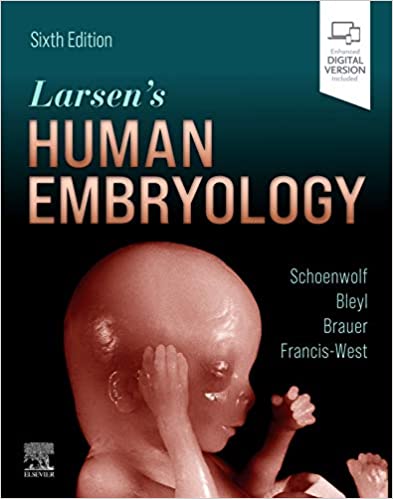Table of Contents
Dedication
Copyright
Content Experts
Preface
Acknowledgments
Video Contents
Introduction
Summary
Why study human embryology?
Periods of Human Embryology
Period of Egg and Embryo: Summary of Main Events
Phases of Human Embryology
Body Axes: Understanding Embryonic Coordinates
Want to Learn More?
1. Gametogenesis, Fertilization, and First Week
Summary
Primordial Germ Cells
Gametogenesis
Spermatogenesis
Oogenesis
Ovulation
Menstrual Cycle
Fertilization
Cleavage
End of First Week: Initiating Implantation
2. Second Week: Becoming Bilaminar and Fully Implanting
Summary
Becoming Fully Implanted
Embryoblast Reorganizes Into Epiblast and Hypoblast
Development of Amniotic Cavity
Development Of Yolk SAC and Chorionic Cavity
Uteroplacental Circulatory System Begins to Develop During the Second Week
3. Third Week: Becoming Trilaminar and Establishing Body Axes
Summary
Overview of Gastrulation: Forming Three Primary Germ Layers and Body Axes
Specifics of Gastrulation: Moving Cells to New Locations and Making Organ Rudiments That Undergo Inductive
Interactions
Formation of Neural Plate
Caudal Elongation of Embryo
Primary Versus Secondary Body Development
4. Fourth Week: Forming the Embryo
Summary
Tube-Within-A-Tube Body Plan Arises Through Body Folding
Neurulation: Establishing Neural Tube, Rudiment of Central Nervous System
Secondary Neurulation
Cranial-Caudal Regionalization of Neural Tube
Neural Crest Cells
Somite Differentiation: Forming Dermamyotome And Sclerotome
5. Principles and Mechanisms of Morphogenesis and Dysmorphogenesis
Summary
Principles of Morphogenesis and Dysmorphogenesis
Animal Models
Using Animal Models to Predict Human Risk
Experimental Techniques
Signaling Pathways
Embryonic Stem Cells, Organoids, and Cloning
6. Fetal Development and the Fetus as a Patient
Summary
During Fetal Period, Embryonic Organ Systems Mature and Fetus Grows
Development of Placenta
Development of Umbilical Cord
Exchange of Substances Between Maternal and Fetal Blood in Placenta
Intrauterine Growth Restriction
Maternal Diabetes and Obesity
Placenta Produces Several Important Hormones
Production and Resorption of Amniotic Fluid
Twinning
Prenatal Diagnosis Assesses Health of Unborn
Treating Fetus in Utero
Fetal Cord Blood and Stem Cells
Preterm Birth
7. Development of the Skin and Its Derivatives
Summary
Origin of Epidermis and Dermis Of Skin
Development of Skin Derivatives
Development of Hair
Development of Sebaceous and Sweat Glands
Development of Mammary Glands
Development of Nails
8. Development of the Musculoskeletal System
Summary
Tissue Origins and Differentiation of Musculoskeletal System
Somites Differentiate Into Sclerotome and Dermamyotome
Resegmentation of Sclerotomes
Myotomes Develop at Segmental Levels
Long Bone and Joint Development
Development of Limb Muscles
9. Development of the Central Nervous System
Summary
Structural Divisions of Nervous System
Functional Divisions of Nervous System
Primary Brain Vesicles Subdivide to form Secondary Brain Vesicles
Formation of Brain Flexures
Cytodifferentiation of Neural Tube
Differentiation of Spinal Cord
Differentiation of Brain
Growth of Brain
10. Development of the Peripheral Nervous System
Summary
Structural Divisions of Nervous System
Functional Divisions of Nervous System
Origin of PNS
Development of Trunk Pns
Development of Cranial Pns
Differences in Preganglionic and Postganglionic Fiber Length Between Parasympathetic and Sympathetic
Divisions of Autonomic Nervous System
11. Development of the Respiratory System and Body Cavities
Summary
Development of Lungs and Respiratory Tree
Partitioning of Coelom and Formation of Diaphragm
12. Development of the Heart
Summary
Establishing Cardiac Lineage
Formation of Primary Heart Tube
Cardiac Looping
Formation of Primitive Blood Vessels Associated With the Endocardial Tube
Coordinated Remodeling of Heart Tube and Primitive Vasculature Produces Systemic and Pulmonary Circulations
Septation of Heart
Development of Pacemaker and Conduction System
Development of Epicardium and Coronary Vasculature
13. Development of the Vasculature
Summary
Formation of Blood and Vasculature Begins Early in Third Week
Vasculogenesis and Angiogenesis
Arteries Versus Veins
Development of Aortic Arch Arteries
Dorsal Aorta Develops Ventral, Lateral, and Posterolateral Branches
Primitive Embryonic Venous System is Divided Into Vitelline, Umbilical, and Cardinal Systems
Development of Lymphatic System
Dramatic Changes Occur in Circulatory System at Birth
14. Development of the Gastrointestinal Tract
Summary
Body Folding
Dorsal Mesentery Initially Suspends Abdominal Gut Tube
Three Regions of Primitive Gut
Development of Abdominal Foregut
Spleen Development
Ventral Mesentery Derivatives
Midgut Development
Cytodifferentiation of Gut Endodermal Epithelium
Development of Outer Intestinal Wall and its Innervation
Hindgut Development
15. Development of the Urinary System
Summary
Three Nephric Systems Arise During Development
Relocation of Kidneys
Contributions of Hindgut Endoderm to Urinary Tract
Development of Suprarenal Gland
16. Development of the Reproductive System
Summary
Reproductive System Arises With Urinary System
In Presence of Y Chromosome, Male Development Occurs
In Absence of Y Chromosome, Female Development Occurs
Development of External Genitalia
Suspension of Mesonephric-Gonadal Complex Within Abdomen
Development of Inguinal Canals
Descent of Testes
Ovaries Become Suspended in Broad Ligament of Uterus And are Held High in Abdominal Cavity by Cranial
Suspensory Ligaments
17. Development of the Pharyngeal Apparatus and Face
Summary
Origin of Skull
Development of Pharyngeal Arches
Development of Face
Development of Nasal and Oral Cavities
Development of Sinuses
Fate of Pharyngeal Clefts
Pharyngeal Arches Give Rise to Tongue
Development of Thyroid Gland
Development of Pharyngeal Pouches
Development of Salivary Glands
Development of Teeth
18. Development of the Ears
Summary
Ear Consists of Three Individual Components
Development of Inner Ear
Development of Middle Ear
Development of External Ear
19. Development of the Eyes
Summary
Eye Originates From Several Embryonic Tissue Layers
Development of Optic Cup and Lens
Development of Eyelids
20. Development of the Limbs
Summary
Epithelial-Mesenchymal Interactions Control Limb Outgrowth
Morphogenesis of Limb
Tissue Origins of Limb Structures
Differentiation of Limb Bones
Innervation of Developing Limb
Figure Credits
Index


